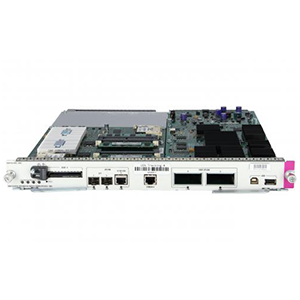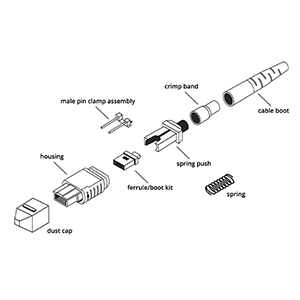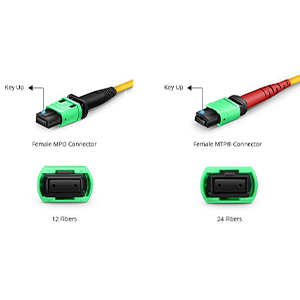I am pleased to introduce you to the 10GBASE-LR optical module, a long-distance transmission optical module designed for 10 Gigabits per second (Gbps) Ethernet. The 10GBASE-LR optical module uses advanced photoelectric conversion and optical modulation technology to provide you with efficient and reliable data transmission solutions.
The working principle of the 10GBASE-LR optical module is based on photoelectric conversion, optical modulation and demodulation technologies. It can convert electrical signals into optical signals and transmit them through optical fibers, and then demodulate the optical signals into electrical signals to realize data transmission and reception.
Introduction to 10GBASE-LR optical module
Definition and background:
The 10GBASE-LR optical module is a long-distance transmission optical module for 10 Gigabits per second (Gbps) Ethernet. It is one of the 10GBASE series optical modules, used to transmit data in optical fiber networks and provide high-speed, high-bandwidth communication connections.
The 10GBASE-LR optical module supports long-distance transmission, where LR stands for “Long Reach”, which means that it can transmit data over a longer distance on an optical fiber link, usually up to 10 kilometers. This makes the 10GBASE-LR optical module very suitable for scenarios that require data transmission over long distances, such as metropolitan area networks (MAN) and wide area networks (WAN).
working principle:
The 10GBASE-LR optical module realizes data transmission through processes such as photoelectric conversion, optical modulation and demodulation.
-
Optical-to-Electrical Conversion: At the transmitting end, the optical module converts electrical signals into optical signals. Usually, data is input into the electrical interface of the optical module in the form of electrical signals, and then the electrical signals are converted into optical signals through the laser inside the optical module.
-
Optical Modulation: After the optical signal is generated by the laser, it is further modulated by the optical modulator. Optical modulators modulate light signals into different light pulses, or intensity changes, to represent the 0s and 1s in binary data.
-
Optical transmission: The modulated optical signal is transmitted through optical fiber and propagated to the receiving end. As a transmission medium, optical fiber realizes the transmission of optical signals through internal light reflection.
-
Optical Demodulation: At the receiving end, the receiver of the optical module receives the transmitted optical signal. The receiver demodulates the received optical signal into an electrical signal through an optical demodulator.
-
Electrical signal processing: The demodulated electrical signal is amplified and shaped by the signal processing circuit, and then output to the receiving device, such as a switch, router or server, in the form of an electrical signal.
The working principle of the 10GBASE-LR optical module is based on optical transmission and photoelectric conversion technology, which can achieve high-speed, long-distance data transmission on optical fiber links. It provides reliable, efficient fiber optic connectivity for 10 Gigabit Ethernet and supports long-distance communication needs.
Features and performance of 10GBASE-LR optical module
Transmission distance:
10GBASE-LR optical modules can usually support long-distance transmission requirements of up to 10 kilometers. LR stands for “Long Reach” and indicates that the optical module is designed to transmit data over longer distances over fiber optic links. This makes the 10GBASE-LR optical module very suitable for applications that need to span longer distances, such as metropolitan area networks (MAN) and wide area networks (WAN).
Fiber type:
The 10GBASE-LR optical module is suitable for single-mode fiber (Single Mode Fiber, SMF). Single-mode fiber is a type of optical fiber that has a smaller fiber core diameter and can transmit optical signals over long distances. In contrast, multimode fiber (MMF) is usually used for short-distance transmission. Therefore, in order to achieve the best performance of the 10GBASE-LR optical module, single-mode fiber needs to be used to match its working requirements.
Wavelength and bandwidth:
The operating wavelength of 10GBASE-LR optical modules is usually 1310 nanometers (nm). This wavelength corresponds to the operating window of single-mode fiber, allowing optical signals to be transmitted with lower loss in single-mode fiber.
10GBASE-LR optical module provides 10 Gbps bandwidth. This high-bandwidth transmission capability enables the optical module to support large-capacity data transmission needs and meet the requirements of high-speed network communication. The bandwidth of 10 Gbps makes the 10GBASE-LR optical module suitable for various data-intensive applications, such as data center interconnection, remote storage and video transmission.
Application fields of 10GBASE-LR optical modules
data center:
10GBASE-LR optical modules are widely used in data centers. Data centers typically require high-speed, reliable interconnection and data transmission to support communication between servers, storage area networks (SANs), and connections between network switches. The 10GBASE-LR optical module can meet the data center’s demand for high-speed, high-capacity connections by providing high bandwidth and long-distance transmission capabilities of 10 Gbps. It can be used to connect servers, storage devices and network devices to achieve fast data transmission and interconnection within the data center.
Teleworking and campus networking:
10GBASE-LR optical modules also play an important role in remote office and campus networks. In a distributed network environment, high-speed connections and data transmission are required at various locations in remote offices and campus networks. The 10GBASE-LR optical module can connect various branches, remote office locations and campus network nodes through single-mode optical fiber, providing fast and reliable network connections for remote office workers and students. It can meet the needs of large-capacity data transmission, video conferencing, remote access and cloud services in distributed environments.
How to install and configure the 10GBASE-LR optical module
Fiber optic connection:
To install and configure the 10GBASE-LR optical module, correct fiber connections are required. Here are guidelines for fiber optic connections:
-
Fiber type: 10GBASE-LR optical module is suitable for single-mode fiber (Single Mode Fiber, SMF). Make sure to use single-mode fiber that is compatible with the optical module.
-
Connector type: 10GBASE-LR optical modules usually use LC (Lucent Connector) type optical fiber connectors. Make sure to use an LC connector that is compatible with the optical module and device interface.
-
Connection steps:
a. Make sure the device is turned off.
b. Insert the LC connector at one end into the optical fiber interface of the 10GBASE-LR optical module, making sure it is inserted correctly and connected securely.
c. Insert the LC connector at the other end into the optical fiber interface of the target device (such as switch, router), making sure it is inserted correctly and connected securely.
d. After ensuring that all connectors are inserted into place, gently pull on the connectors to ensure a secure connection. -
Depending on the equipment and network requirements, it may be necessary to configure the optical fiber interface parameters of the relevant equipment, such as speed, duplex mode, etc. Please refer to the device’s user manual or operating guide for configuration.
Device compatibility:
Before installing the 10GBASE-LR optical module, you need to ensure the compatibility of the device. Here are some key points for device compatibility:
-
Switches and routers: Make sure that the switch or router used supports 10GBASE-LR optical modules and has corresponding optical fiber interfaces. Check the device’s specifications or compatibility list to ensure that the device supports 10GBASE-LR optical modules.
-
Optical module interface specification: Check the optical module interface specification of the device to ensure that it matches the interface type and specification of the 10GBASE-LR optical module. Common optical module interface specifications include XFP, SFP+, etc. Ensure interface compatibility between devices and optical modules.
-
Optical module driver and firmware: For some devices, it may be necessary to install the appropriate optical module driver or update the optical module’s firmware to ensure normal recognition and functionality of the optical module.
Before installing and configuring the 10GBASE-LR optical module, it is recommended to carefully read the documentation of the device and optical module and confirm with the device manufacturer to ensure device compatibility and correct installation steps.
Advantages and considerations of 10GBASE-LR optical modules
Long distance transmission:
The 10GBASE-LR optical module has significant advantages in long-distance transmission. It can support a transmission distance of up to 10 kilometers, allowing data to be transmitted over longer distances. This makes the 10GBASE-LR optical module very suitable for scenarios where data needs to be transmitted over long distances such as metropolitan area networks (MAN) and wide area networks (WAN). In contrast, other types of optical modules, such as 10GBASE-SR, are suitable for short-distance transmission, and their transmission distances are usually within a few hundred meters.
Low power consumption and stability:
The 10GBASE-LR optical module also has advantages in terms of power consumption and stability. It usually adopts a low-power design, which can maintain low energy consumption while transmitting at high speed. This is important for energy conservation and sustainability, especially in large-scale data center and network deployments. In addition, the 10GBASE-LR optical module is also stable and can provide reliable data transmission. It has been rigorously tested and verified to ensure stable performance under different environmental conditions. This is very important for applications that have high requirements on the stability and reliability of network connections, such as data centers and critical networks.
Summarize:
The 10GBASE-LR optical module is a long-distance transmission optical module specially designed for 10 Gigabits per second (Gbps) Ethernet. It has advanced photoelectric conversion and optical modulation technology. By using single-mode fiber (SMF), 1310 nanometer (nm) wavelength and 10 Gbps bandwidth requirements, it is able to provide stable and reliable data transmission over distances of up to 10 kilometers. By choosing the 10GBASE-LR optical module, you will gain the advantages of long-distance transmission, low power consumption and stability, providing excellent performance and reliability for your network.
- What is a 10GBASE-LR SFP module?
- What is an LR optic?
- What is the difference between SFP-10G-LR-S and SFP-10G-LR?
- What is the difference between MA SFP 10gb LR and MA SFP 10gb SR?
- What is SFP optical module?
- What does LR mean on SFP?
- What is the range of SFP 10GBASE-LR?
- What is the difference between SFP and SFP module?





